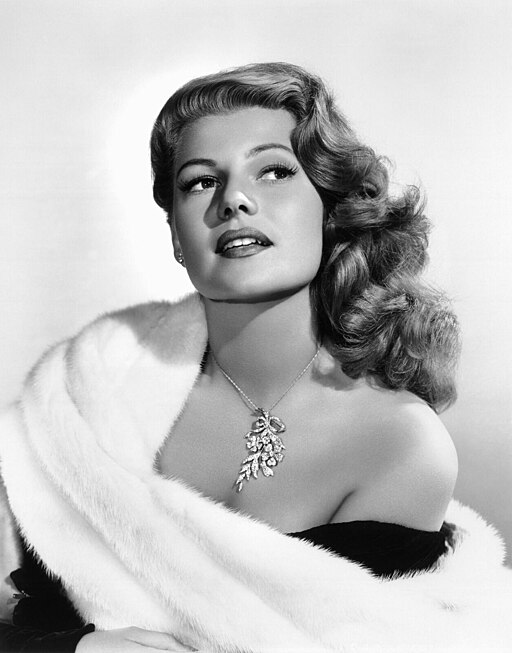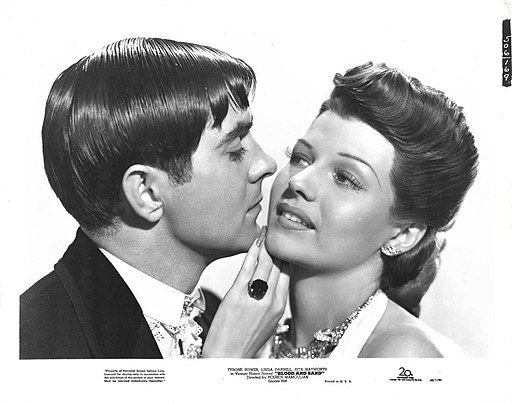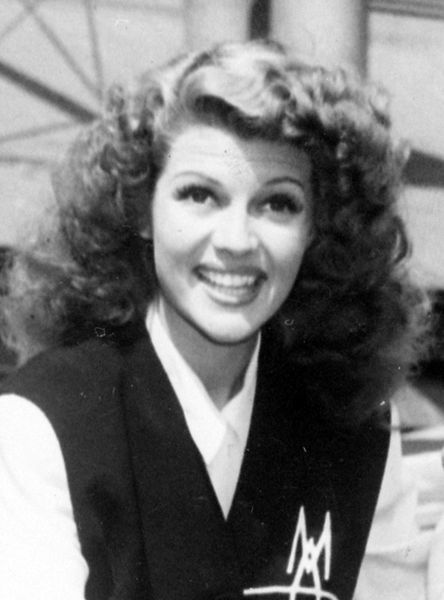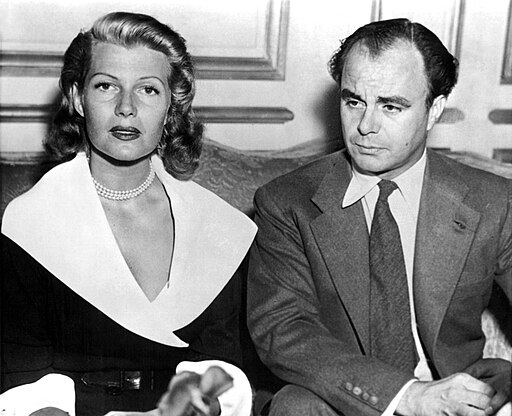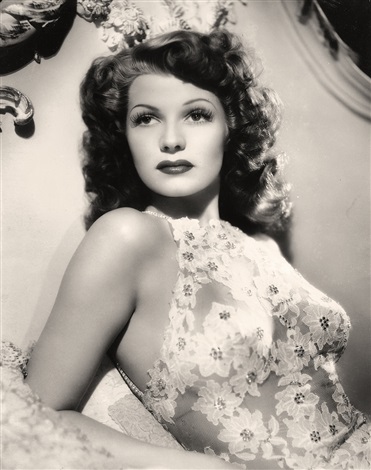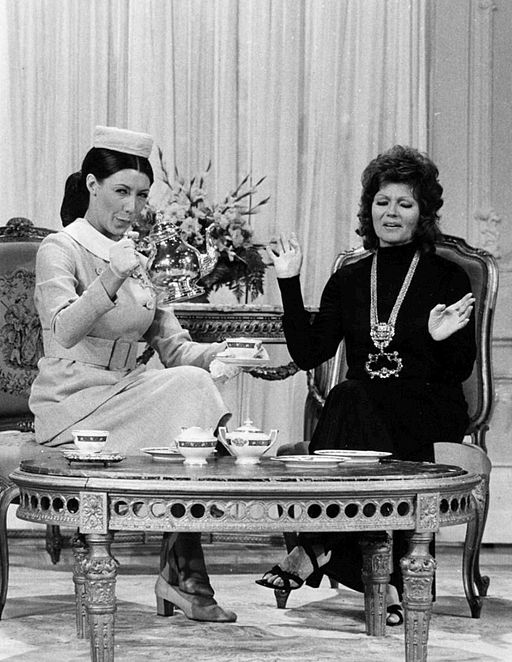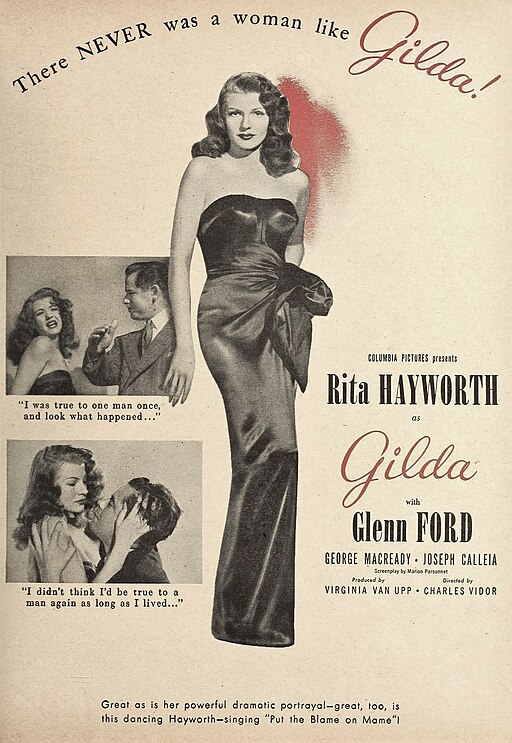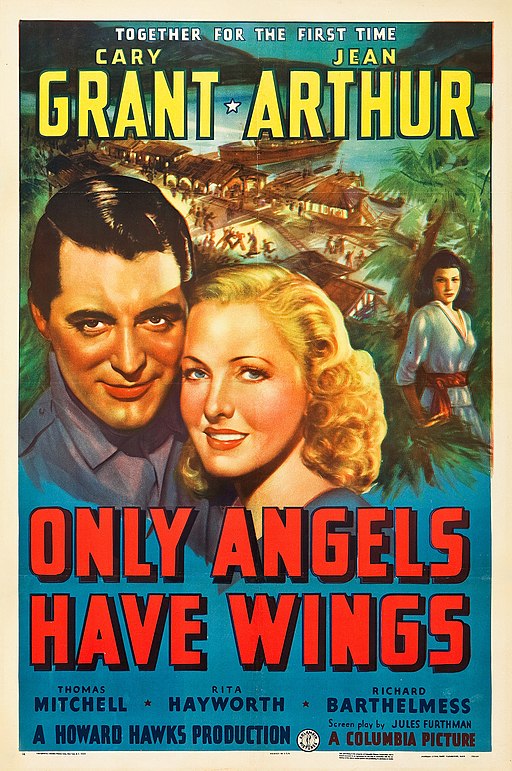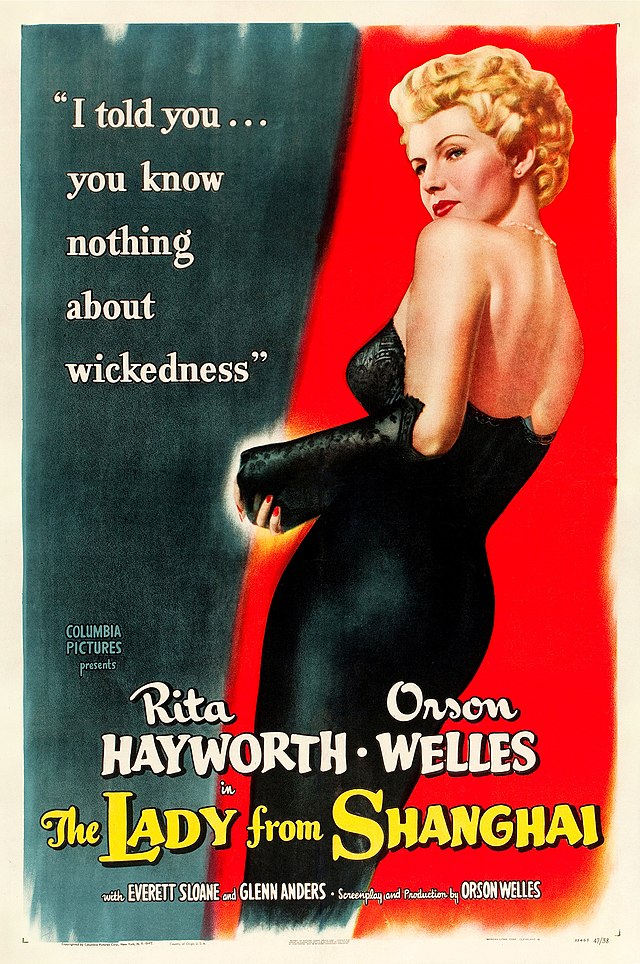Rita Hayworth
back| Full Name | Margarita Carmen Cansino |
| Stage Name | Rita Hayworth |
| Born | October 17, 1918 |
| Birthplace | Brooklyn, New York, U.S. |
| Died | May 14, 1987 |
| Buried | Holy Cross Cemetery, Culver City, California, U.S. |
| Married to | Edward Charles Holmgren Judson (1937-1942) - Orson Welles (1943-1947) - Prince Aly Khan (1949-1953) - Dick Haymes (1953-1955) - James Hill (1958-1961) |
| Children | Rebecca Welles (daughter with Orson Welles) - Princess Yasmin Aga Khan (daughter with Prince Aly Khan) |
| Notable films | Gilda (1946) - The Lady from Shanghai (1947) - Cover Girl (1944) - Only Angels Have Wings (1939) - Pal Joey (1957) |
Rita Hayworth
The Love Goddess
Rita Hayworth was an iconic American actress and dancer, celebrated as a major star during Hollywood's golden era. Transforming from a dancer into a glamorous film icon, she is best known for her captivating performances in films like Gilda (1946) and The Lady from Shanghai (1947).
Hayworth's allure and dramatic prowess made her a cinematic legend, earning her the moniker "The Love Goddess." Despite her on-screen success, her personal life was marked by tumultuous marriages, including high-profile unions with Orson Welles and Prince Aly Khan.
Related
Rita Hayworth (1918 – 1987)
Biography and Career Overview
Rita Hayworth, born Margarita Carmen Cansino on October 17, 1918, in Brooklyn, New York, was an emblematic figure of Hollywood’s golden era, epitomizing glamour and an enigmatic allure that captivated audiences worldwide. Her life story is a blend of dazzling cinematic success and personal struggles, encapsulating the highs and lows of stardom.
Early Life and Entry into Show Business
Rita was born into a show business family. Her father, Eduardo Cansino, was a dancer from Spain who had immigrated to the United States, where he met Volga Hayworth, an American dancer of Irish-English descent. From a young age, Rita was groomed for the stage. Under the tutelage of her father, she learned the art of dance and performed in the family’s vaudeville act, which helped her develop the poise and grace that later defined her cinematic presence.
Hollywood and Rise to Stardom
Rita’s transition from a dancer to a film actress began in the early 1930s when her family moved to Hollywood. She first caught the eye of film producers because of her dancing skills and exotic beauty. After several minor roles, her big break came when she signed with Columbia Pictures. The studio head, Harry Cohn, played a pivotal role in transforming her into a glamorous movie star. He changed her name from Margarita Cansino to Rita Hayworth and orchestrated a series of changes to her appearance, including making her a redhead, which became her signature look.
Hayworth’s rise to stardom was meteoric during the 1940s, with standout performances in films like Only Angels Have Wings (1939), Cover Girl (1944), and her iconic role in Gilda (1946). In Gilda, Hayworth's portrayal of the seductive title character, especially in the scene where she performs a sultry glove removal, solidified her status as a sex symbol and one of Hollywood's most desirable actresses.
Marriages and Personal Life
Rita Hayworth’s personal life, particularly her marriages, was highly publicized and often tumultuous. She was married five times, including to Orson Welles, with whom she had her first child, Rebecca. Her marriage to Prince Aly Khan was particularly notable, bringing her into the world of international aristocracy and leading to the birth of her second daughter, Princess Yasmin Aga Khan. Despite the glamour, her marriages were marked by struggles, including infidelity and financial difficulties, contributing to their eventual dissolution.
Passions and Interests
Beyond her film career, Rita was passionate about dancing, a love instilled in her from childhood. She was also an avid reader and had a profound interest in improving her craft, studying acting earnestly to tackle more demanding roles. Despite her public persona, Rita was known to be remarkably down-to-earth and dedicated to her children, striving to provide a stable home amidst her hectic and public life.
Later Years, Death, and Legacy
Rita Hayworth’s later years were overshadowed by her health struggles. She withdrew from the spotlight and faced a series of health issues, including Alzheimer's disease, which was not diagnosed until 1980 after years of symptoms that were misattribated to alcoholism. Her condition brought significant attention to Alzheimer’s, helping to raise awareness and funds for research. Rita Hayworth passed away on May 14, 1987, from complications related to the disease. She was laid to rest in Holy Cross Cemetery in Culver City, California.
Rita Hayworth remains a symbol of Hollywood glamour and a testament to the era of classical cinema. Her legacy is not only in her films but also in her impact on the public understanding of Alzheimer’s disease, making her a figure of enduring fascination and respect.
Documentary on Rita Hayworth:
Selected Movies Starring Rita Hayworth:
1930s
- 1935: "Dante's Inferno" - In a minor role, Hayworth appears in this drama about a carnival barker and his ascent to power in the amusement park industry.
- 1939: "Only Angels Have Wings" - Hayworth plays Judy MacPherson, a showgirl involved in a complex love triangle in this adventure film about mail pilots in South America.
1940s
- 1940: "Music in My Heart" - A romantic musical where Hayworth plays Patricia O'Malley, who falls in love with a stowaway on her way to marry another man.
- 1941: "Blood and Sand" - She stars as Doña Sol, a seductive woman who becomes involved with a famous matador, contributing to his downfall.
- 1942: "You Were Never Lovelier" - A musical comedy where Hayworth shines as Maria Acuña, who falls for an American dancer played by Fred Astaire.
- 1944: "Cover Girl" - This musical features Hayworth as Rusty Parker, a dancer who wins a contest to become a celebrated cover girl, complicating her personal life.
- 1946: "Gilda" - In her most iconic role, Hayworth plays the titular character, a femme fatale entangled in a troubled marriage with a casino owner in Buenos Aires.
- 1947: "The Lady from Shanghai" - Directed by Orson Welles, Hayworth portrays Elsa Bannister, a mysterious woman involved in a deadly plot.
- 1948: "The Loves of Carmen" - Hayworth plays Carmen, a passionate gypsy woman whose affairs lead to betrayal and tragedy.
1950s
- 1952: "Affair in Trinidad" - As Chris Emery, Hayworth gets involved in espionage and murder in Trinidad while trying to uncover her husband's killer.
- 1953: "Salome" - She portrays Princess Salome, known for the "Dance of the Seven Veils," in this biblical drama about King Herod's stepdaughter.
- 1957: "Pal Joey" - As Vera Simpson, a wealthy former stripper, Hayworth becomes entangled with a nightclub singer played by Frank Sinatra.
- 1958: "Separate Tables" - In a drama set in a British seaside hotel, Hayworth plays Ann Shankland, who visits to seek reconciliation with her ex-husband.
1960s
- 1961: "The Happy Thieves" - Hayworth is Eve Lewis, part of a sophisticated couple who steal a priceless painting from a Spanish museum.
- 1964: "Circus World" - She plays Lili Alfredo in a drama centered around a circus owner struggling to keep his show afloat and his past buried.
1970s
- 1972: "The Wrath of God" - In her final film, Hayworth portrays Señora De La Plata, an innkeeper in a Central American village involved in local intrigues.
Analysis of the Acting Style of Rita Hayworth:
Rita Hayworth's acting style was marked by a blend of innate charisma, emotive expressiveness, and a magnetic screen presence that made her one of the most captivating stars of Hollywood's golden era. Her performances were characterized by an understated elegance and an ability to convey complex emotions with subtle gestures and expressions, which resonated deeply with audiences.
Subtlety and Nuance
Hayworth excelled in roles that required a combination of vulnerability and strength, often portraying characters with a layered internal world. Her acting style was not about grand gestures but rather the small, nuanced ones that could convey a wide range of emotions from joy and seduction to despair and resilience. In films like Gilda and The Lady from Shanghai, her ability to project both allure and depth with a simple glance or a fleeting smile was central to her performances. Her eyes were particularly expressive, often communicating much more than her dialogue could.
Glamour and Grace
As a trained dancer, Hayworth brought a unique physicality to her roles. Her movements were fluid and graceful, contributing to the glamorized image of her characters. This physical grace translated into a screen persona that was both glamorous and approachable, allowing her to embody the femme fatale archetype in Gilda with as much ease as she portrayed the charming and lively dancer in You Were Never Lovelier. Her dance background helped her in musicals, where her rhythmic timing and poise were always on display, enhancing her performances beyond the average musical star's capabilities.
Emotional Accessibility
Hayworth had a gift for making her characters relatable. Despite the often glamorous and unattainable facade, she brought a warmth and genuineness to her roles that bridged the gap between the viewer and the silver screen. Her performances in romantic comedies and dramas showcased her ability to toggle between light-hearted charm and serious emotional depth, often within the same scene. This accessibility made her characters beloved and memorable.
Versatility Across Genres
While she is often remembered for her roles in dramatic films and musicals, Hayworth's versatility across different genres was a testament to her acting skills. Whether in a comedy, a noir thriller, or a romantic drama, she adapted her style to fit the tone and requirements of the film, demonstrating her broad range as an actress. Each performance was imbued with her distinctive flair, yet she was flexible enough to disappear into different personas, a hallmark of true acting prowess.
Legacy and Influence
Rita Hayworth's acting style has left a lasting impact on the film industry. Her ability to blend subtlety with expressiveness, coupled with her undeniable charisma, created a model for screen performances that many actresses have aspired to emulate. Her portrayal of complex, multifaceted women paved the way for more nuanced roles for women in cinema, challenging the stereotypes of her time and broadening the scope of how actresses could captivate and enchant their audiences.
Awards and Recognition:
Golden Globe Awards
1972: Rita Hayworth was nominated for the Golden Globe for Best Actress in a Motion Picture – Drama for her role in "The Wrath of God". However, she did not win.
Cannes Film Festival
1953: Rita was awarded the title of "World Film Favorite - Female" based on popularity in this year at the Cannes Film Festival. This award was more about global popularity and appeal rather than specific performances.
Honorary Recognitions
Beyond these, much of Rita Hayworth's recognition has come in the form of honorary awards and posthumous acknowledgments for her contribution to the film industry:
American Film Institute (AFI)
AFI's 100 Years... 100 Stars: Hayworth was named one of American film's greatest legends in AFI's 1999 centennial celebration.
Postal Stamp
2011: Rita Hayworth was commemorated by the United States Postal Service as part of its "Legends of Hollywood" postage stamp series.
The relative scarcity of formal accolades during Rita Hayworth's career can be attributed to several factors. During the peak of her career, the competitive landscape of awards like the Oscars was intensely fierce, and many of her films, while commercially successful and critically acclaimed, were not always the type of films that garnered Academy Awards attention. Additionally, the types of roles she played—often more focused on glamour and allure rather than the gritty, deeply transformative roles that tend to attract awards—might also have influenced her awards trajectory.
Memorable Quotes from Rita Hayworth:
Memorable Quotes from Her Films
From Gilda (1946): "If I'd been a ranch, they would have named me the Bar Nothing."
This line, delivered by Hayworth in her role as Gilda, is full of wit and is one of the defining moments that capture her character's sultry yet sharp-tongued personality.
From Gilda (1946): "I'm not good. I'm not very bad either. I'm just right."
As Gilda, Hayworth delivered this line with a mix of defiance and vulnerability, perfectly summarizing the complex nature of her character.
Personal Quotes
On stardom: "Every man I knew went to bed with Gilda... and woke up with me."
This poignant reflection captures the dissonance between Hayworth's public persona and her private identity, highlighting the challenges of her fame.
On her career: "Basically, I am a good, gentle person, but I am attracted to mean personalities."
This quote reflects on her personal relationships, notably her tumultuous marriages, which were often in the public eye.
On her image: "They go to bed with Gilda, they wake up with me."
Similar to the first, this quote deeply expresses how her real-life and screen persona were conflated in the eyes of the public and her lovers, leading to disappointments in her personal relationships.
On life lessons: "All I wanted was just what everybody else wants, you know, to be loved."
A simple yet powerful statement that reflects her fundamental desires and the universal quest for love and acceptance.
What Others said about Rita Hayworth:
- Orson Welles, her second husband and director of The Lady from Shanghai, once described her by saying, "Rita was one of the dearest and sweetest women that ever lived. She was also beautiful; maybe that had something to do with it, but it was really her sweetness and intelligence that charmed me."
- Fred Astaire, her co-star in You Were Never Lovelier and You'll Never Get Rich, praised her work ethic and talent, especially her dancing. Astaire regarded Hayworth as one of his favorite dance partners, famously remarking, "Rita danced with trained perfection and individuality. She was terrific to work with."
- James Agee, a respected film and book critic, wrote of her performance in Gilda: "Hayworth makes of Gilda a swift, complex sketch of a sluttish, cynical, childishly selfish, and wonderfully generous woman."
- Life Magazine described Rita Hayworth as a "tantalizing mixture of lady and tigress all in one," highlighting her dual appeal as both a glamorous icon and a relatable human being.
- Jean-Luc Godard, the French-Swiss director, famously used a poster of Hayworth in Gilda as a key visual motif in his groundbreaking film Breathless (1960), suggesting her emblematic status in the realm of cinematic and cultural icons.
- Madonna, the pop icon, included Rita Hayworth in her song "Vogue" among other golden-era Hollywood legends, cementing Hayworth's status as a timeless symbol of glamour and beauty.
- Her daughter, Princess Yasmin Aga Khan, has spoken about Rita not just as a star but as a mother. She has been involved in raising awareness for Alzheimer's disease, the illness that afflicted Hayworth, and often speaks of her mother's struggles with great empathy and affection, helping to humanize the star’s later life challenges.
List of Movies with Rita Hayworth:
- 1935: Dante's Inferno
- 1935: Paddy O'Day
- 1935: Under the Pampas Moon
- 1935: Charlie Chan in Egypt
- 1936: Human Cargo
- 1936: Meet Nero Wolfe
- 1936: Rebellion
- 1937: Criminals of the Air
- 1937: Hit the Saddle
- 1937: Old Louisiana
- 1937: Trouble in Texas
- 1937: The Game That Kills
- 1937: Paid to Dance
- 1937: Girls Can Play
- 1938: Who Killed Gail Preston?
- 1938: Special Inspector
- 1938: There's Always a Woman
- 1938: Juvenile Court
- 1938: The Renegade Ranger
- 1938: Convicted
- 1939: Homicide Bureau
- 1939: The Lone Wolf Spy Hunt
- 1939: Only Angels Have Wings
- 1940: Music in My Heart
- 1940: Blondie on a Budget
- 1940: Susan and God
- 1940: Angels Over Broadway
- 1941: The Strawberry Blonde
- 1941: Affectionately Yours
- 1941: Blood and Sand
- 1941: You'll Never Get Rich
- 1942: The Lady is Willing
- 1942: My Gal Sal
- 1942: You Were Never Lovelier
- 1942: Tales of Manhattan
- 1944: Cover Girl
- 1945: Tonight and Every Night
- 1946: Gilda
- 1947: Down to Earth
- 1947: The Lady from Shanghai
- 1948: The Loves of Carmen
- 1951: Affair in Trinidad
- 1952: The Happy Thieves
- 1953: Salome
- 1957: Fire Down Below
- 1957: Pal Joey
- 1958: Separate Tables
- 1959: They Came to Cordura
- 1961: The Happy Thieves
- 1964: Circus World
- 1966: The Money Trap
- 1967: The Rover
- 1968: I Bastardi (The Bastard)
- 1970: The Naked Zoo
- 1971: The Wrath of God

